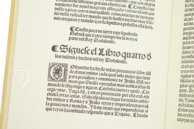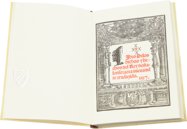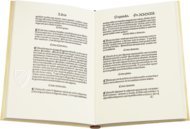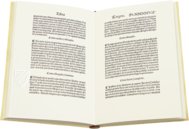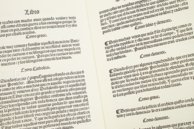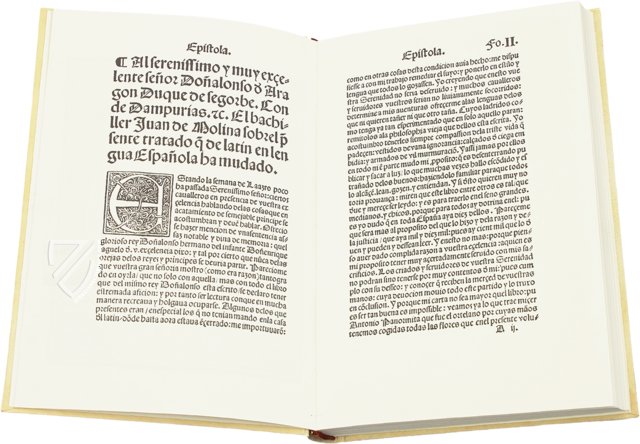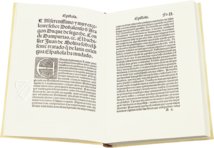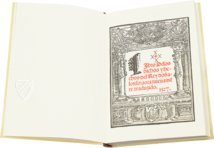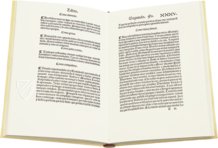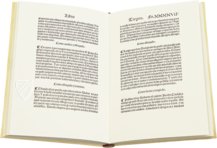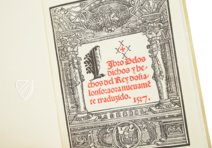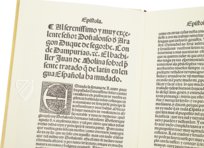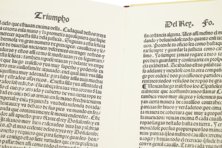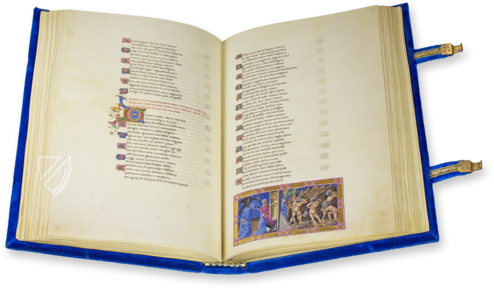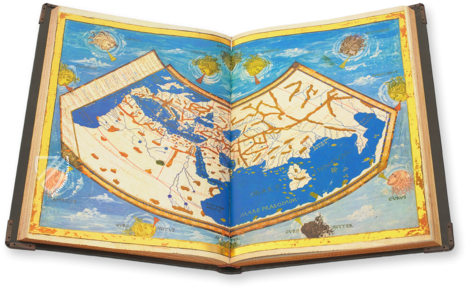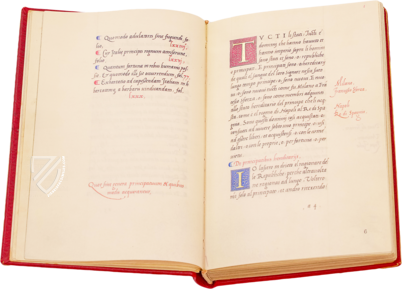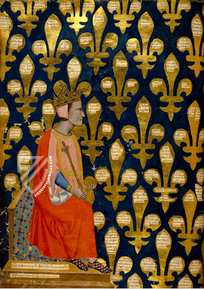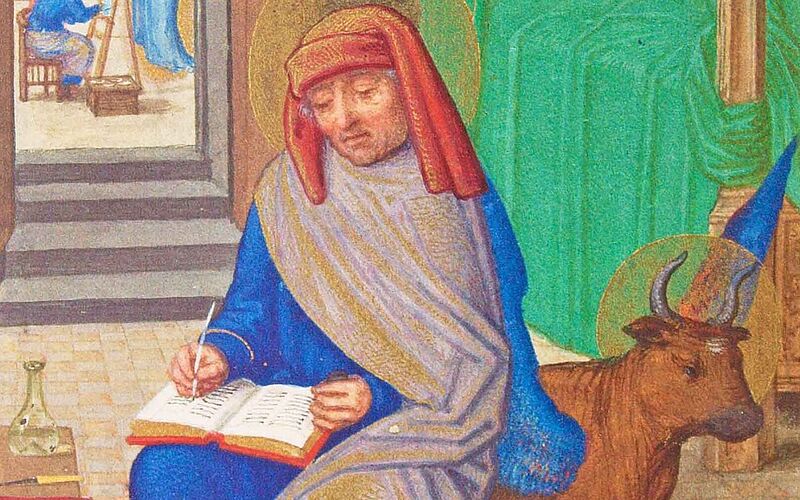Libro de los dichos y hechos del rey don Alonso
(under 1,000€)
The Libro de los Dichos y Hechos del Rey Don Alonso tells of the deeds and virtues of King Alfonso V of Aragon, called “the Magnanimous.” The literary masterpiece was published in a Valencian print shop in 1527, but was only intended for a small circle of wealthy readers. Aside from the adventurous portrayals of the life of the great King Alfonso, the precious work distinguishes itself through a special illustration on its title page.
Libro de los Dichos y Hechos del Rey Don Alonso
The Book of the Deeds and Virtues of King Alfonso V, so translates the title of this Spanish literary classic into English. It is the first chronology of the adventures of King Alfonso V, who bore the epithet “the Magnanimous”. This special codex is a unique specimen of this historically valuable text and originates from a printer in Valencia. The interestingly written and reader-friendly story is furnished here with preciously colored printed graphics completely in the style of the Renaissance.
A Special Literary Treasure
The edition at hand of the tales of Alfonso V was printed in 1527. The work begins with a fantastic xylographic depiction of Juan Joffre’s coat of arms, who was responsible for the print. Never before had a print shop furnished their books with their own escutcheon. The fantastic printed graphic shows a mermaid with two tails. It is a special coincidence that this specimen of the precious incunabulum exists still today. The original work is not be found in any state library or in all of Spain for that matter, but rather they were probably manufactured primarily for wealthy private owners.
A Renowned Author
The masterful tale was written by Antonio Panormitano, a Sicilian Renaissance Humanist. In Bologna in 1425, Panormitano published a Latin collection of obscene and satirical epigrams with the title Hemaphroditus, which was dedicated to Cosimo de’ Medici. In the year 1429, he was the court poet of Duke Filippo Maria Visconti. Six year later Panormitano came to the court of Alfonso V. Here he became a professor of theology at a monastery near Naples, where King Alfonso V spent most of his life. He was named Alfonso’s personal secretary and was one of his closest confidants. Juan de Molina translated the Italian descriptions into Spanish. Molina, who is counted among the most esteemed authors of his time, composed inter alia the Chronicles of the Catholic Monarchs.
Fascinating Reading Material
Alfonso V of Aragon was the son and heir of Ferdinand the Just and his wife Eleanor of Alburquerque. He ascended the throne of the Kingdom of Aragon at the age of 20. He was also King of Naples and Sicily as Alfonso I. Numerous legends are wrapped around the life of the great king. One example is the tale of his military campaign again Genoa. He was supposedly defeated in a sea battle by the Genoese fleet near the island of Ponza, taken prisoner with his brother, and delivered to Duke Filippo Maria Visconti. Having said this, Alfonso V managed to secure his release and win the support of Milan. After a five-year struggle, Pope Eugene IV crowned him the ruler of Naples. He was considered to be a clever and mild monarch, even if he was inclined to sensuality and a love of magnificence. It is believed in scholarship that after the Fall of Constantinople in 1453, Alfonso V accepted scholars fleeing from the city. The descriptions of the monarch’s adventures illustrate his flamboyant life in a unique way.
Codicology
- Size / Format
- 146 pages / 22.5 × 15.5 cm
- Origin
- Spain
- Date
- 1527
- Epochs
- Style
- Language
- Script
- Gothic script
- Illustrations
- Extraordinary title page and engraved initials
- Content
- Description of the deeds and virtues of King Alfonso V of Aragon, called "the Magnanimous"
- Artist / School
- Antonio Panormitano (author)
Juan de Molina (translator)
Juan Joffre (printer)
Libro de los dichos y hechos del rey don Alonso
Title Page
Today, the so-called “front matter” found at the beginning of books is fairly standardized in terms of information and format so that the modern reader knows where to find everything from the title and author to the publisher and edition. Medieval readers did not have this luxury and thus many works from the period are merely named after the first few words that appear in the text.
This decorative woodcut presents the title and date of publication in a classical architectural frame with the coat of arms of the printer Juan Joffe, which consists of a mermaid with two tails that she holds in her hands, flanked by two fish. It is the first time a printer furnished a book with their own escutcheon and represents a forerunner of a modern company logo.
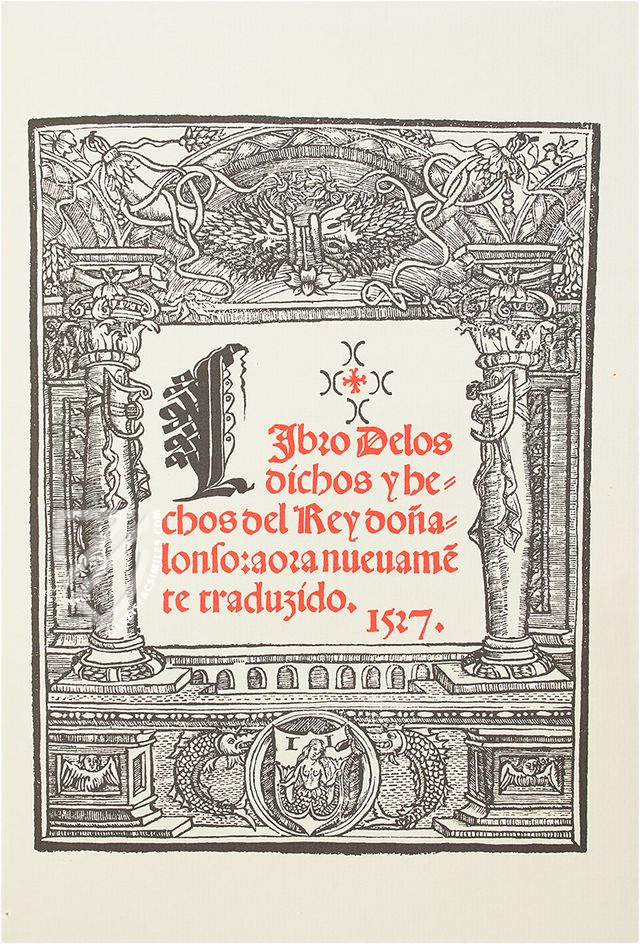
#1 Libro de los dichos y hechos del rey don Alonso
Language: Spanish
(under 1,000€)
- Treatises / Secular Books
- Apocalypses / Beatus
- Astronomy / Astrology
- Bestiaries
- Bibles / Gospels
- Chronicles / History / Law
- Geography / Maps
- Saints' Lives
- Islam / Oriental
- Judaism / Hebrew
- Single Leaf Collections
- Leonardo da Vinci
- Literature / Poetry
- Liturgical Manuscripts
- Medicine / Botany / Alchemy
- Music
- Mythology / Prophecies
- Psalters
- Other Religious Books
- Games / Hunting
- Private Devotion Books
- Other Genres
- Afghanistan
- Armenia
- Austria
- Belgium
- Colombia
- Croatia
- Cyprus
- Czech Republic
- Denmark
- Egypt
- Ethiopia
- France
- Germany
- Greece
- Hungary
- India
- Iran
- Iraq
- Israel
- Italy
- Japan
- Lebanon
- Luxembourg
- Mexico
- Morocco
- Netherlands
- Palestine
- Peru
- Poland
- Portugal
- Russia
- Serbia
- Spain
- Sri Lanka
- Sweden
- Switzerland
- Syria
- Turkey
- Ukraine
- United Kingdom
- United States
- Uzbekistan
- Aboca Museum
- Ajuntament de Valencia
- Akademie Verlag
- Akademische Druck- u. Verlagsanstalt (ADEVA)
- Aldo Ausilio Editore - Bottega d’Erasmo
- Alecto Historical Editions
- Alkuin Verlag
- Almqvist & Wiksell
- Amilcare Pizzi
- Andreas & Andreas Verlagsbuchhandlung
- Archa 90
- Archiv Verlag
- Archivi Edizioni
- Arnold Verlag
- ARS
- Ars Magna
- ArtCodex
- AyN Ediciones
- Azimuth Editions
- Badenia Verlag
- Bärenreiter-Verlag
- Belser Verlag
- Belser Verlag / WK Wertkontor
- Benziger Verlag
- Bernardinum Wydawnictwo
- BiblioGemma
- Biblioteca Apostolica Vaticana (Vaticanstadt, Vaticanstadt)
- Bibliotheca Palatina Faksimile Verlag
- Bibliotheca Rara
- Boydell & Brewer
- Bramante Edizioni
- Bredius Genootschap
- Brepols Publishers
- British Library
- C. Weckesser
- Caixa Catalunya
- Canesi
- CAPSA, Ars Scriptoria
- Caratzas Brothers, Publishers
- Carus Verlag
- Casamassima Libri
- Chavane Verlag
- Christian Brandstätter Verlag
- Circulo Cientifico
- Club Bibliófilo Versol
- Club du Livre
- CM Editores
- Collegium Graphicum
- Collezione Apocrifa Da Vinci
- Comissão Nacional para as Comemorações dos Descobrimentos Portugueses
- Coron Verlag
- Corvina
- CTHS
- D. S. Brewer
- Damon
- De Agostini/UTET
- De Nederlandsche Boekhandel
- De Schutter
- Deuschle & Stemmle
- Deutscher Verlag für Kunstwissenschaft
- DIAMM
- Droz
- E. Schreiber Graphische Kunstanstalten
- Ediciones Boreal
- Ediciones Grial
- Ediclube
- Edições Inapa
- Edilan
- Editalia
- Edition Deuschle
- Edition Georg Popp
- Edition Leipzig
- Edition Libri Illustri
- Editiones Reales Sitios S. L.
- Éditions de l'Oiseau Lyre
- Editions Medicina Rara
- Editorial Casariego
- Editorial Mintzoa
- Editrice Antenore
- Editrice Velar
- Edizioni Edison
- Egeria, S.L.
- Eikon Editores
- Electa
- Emery Walker Limited
- Enciclopèdia Catalana
- Eos-Verlag
- Ephesus Publishing
- Ernst Battenberg
- Eugrammia Press
- Extraordinary Editions
- Fackelverlag
- Facsimila Art & Edition
- Facsimile Editions Ltd.
- Facsimilia Art & Edition Ebert KG
- Faksimile Verlag
- Feuermann Verlag
- Folger Shakespeare Library
- Franco Cosimo Panini Editore
- Friedrich Wittig Verlag
- Fundación Hullera Vasco-Leonesa
- G. Braziller
- Gabriele Mazzotta Editore
- Gebr. Mann Verlag
- Gesellschaft für graphische Industrie
- Getty Research Institute
- Giovanni Domenico de Rossi
- Giunti Editore
- Graffiti
- Grafica European Center of Fine Arts
- Guido Pressler
- Guillermo Blazquez
- Gustav Kiepenheuer
- H. N. Abrams
- Harrassowitz
- Helikon
- Hendrickson Publishers
- Henning Oppermann
- Herder Verlag
- Hes & De Graaf Publishers
- Hoepli
- Holbein-Verlag
- Hortus Deliciarum
- Houghton Library
- Hugo Schmidt Verlag
- Idion Verlag
- Il Bulino, edizioni d'arte
- ILte
- Imago
- Insel Verlag
- Instituto Nacional de Antropología e Historia
- Istituto dell'Enciclopedia Italiana - Treccani
- Istituto Ellenico di Studi Bizantini e Postbizantini
- Istituto Geografico De Agostini
- Istituto Poligrafico e Zecca dello Stato
- Italarte Art Establishments
- J. Thorbecke
- Jan Thorbecke Verlag
- Johnson Reprint Corporation
- Josef Stocker
- Josef Stocker-Schmid
- Jugoslavija
- Karl W. Hiersemann
- Kasper Straube
- Kaydeda Ediciones
- Kindler Verlag / Coron Verlag
- Kodansha International Ltd.
- Konrad Kölbl Verlag
- Kurt Wolff Verlag
- La Liberia dello Stato
- La Linea Editrice
- La Meta Editore
- Lambert Schneider
- Landeskreditbank Baden-Württemberg
- Leo S. Olschki
- Les Incunables
- Library of Congress
- Libreria Musicale Italiana
- Lichtdruck
- Lito Immagine Editore
- Lumen Artis
- Lund Humphries
- M. Moleiro Editor
- Maison des Sciences de l'homme et de la société de Poitiers
- Manuscriptum
- Martinus Nijhoff
- Maruzen-Yushodo Co. Ltd.
- MASA
- McGraw-Hill
- Militos
- Millennium Liber
- Müller & Schindler
- Nahar and Steimatzky
- National Library of Wales
- Neri Pozza
- Nova Charta
- Oceanum Verlag
- Odeon
- Orbis Mediaevalis
- Orbis Pictus
- Österreichische Staatsdruckerei
- Oxford University Press
- Pageant Books
- Parzellers Buchverlag
- Patrimonio Ediciones
- Pattloch Verlag
- PIAF
- Pieper Verlag
- Plon-Nourrit et cie
- Prestel Verlag
- Princeton University Press
- Prisma Verlag
- Priuli & Verlucca, editori
- Pro Sport Verlag
- Propyläen Verlag
- Pytheas Books
- Quaternio Verlag Luzern
- Reales Sitios
- Recht-Verlag
- Reichert Verlag
- Reichsdruckerei
- Riehn & Reusch
- Roberto Vattori Editore
- Rosenkilde and Bagger
- Roxburghe Club
- Salerno Editrice
- Sarajevo Svjetlost
- Schöck ArtPrint Kft.
- Scolar Press
- Scrinium
- Scripta Maneant
- Scriptorium
- Siloé, arte y bibliofilia
- SISMEL - Edizioni del Galluzzo
- Sociedad Mexicana de Antropología
- Société des Bibliophiles & Iconophiles de Belgique
- Soncin Publishing
- Sorli Ediciones
- Stainer and Bell
- Studer
- Styria Verlag
- Sumptibus Pragopress
- Szegedi Tudomànyegyetem
- Taberna Libraria
- Tarshish Books
- Taschen
- Tempus Libri
- Testimonio Compañía Editorial
- Thames and Hudson
- The Clear Vue Publishing Partnership Limited
- The Facsimile Codex
- The Folio Society
- The Marquess of Normanby
- The Richard III and Yorkist History Trust
- Tip.Le.Co
- TouchArt
- TREC Publishing House
- TRI Publishing Co.
- Trident Editore
- Typis Regiae Officinae Polygraphicae
- Union Verlag Berlin
- Universidad de Granada
- University of California Press
- University of Chicago Press
- Urs Graf
- Vallecchi
- Van Wijnen
- VCH, Acta Humaniora
- VDI Verlag
- VEB Deutscher Verlag für Musik
- Verlag Anton Pustet / Andreas Verlag
- Verlag Bibliophile Drucke Josef Stocker
- Verlag der Münchner Drucke
- Verlag für Regionalgeschichte
- Verlag Styria
- Vicent Garcia Editores
- W. Turnowsky
- Waanders Printers
- Wiener Mechitharisten-Congregation (Wien, Österreich)
- Wissenschaftliche Buchgesellschaft
- Wydawnictwo Dolnoslaskie
- Xuntanza Editorial
- Zakład Narodowy
- Zollikofer AG






